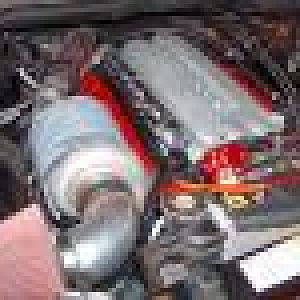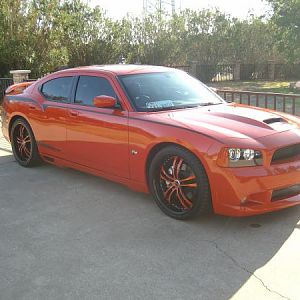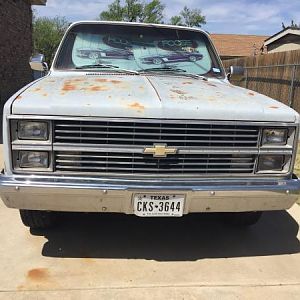Anyone know what would cause my brake and ABS dash lights to come on when driving? The next time I start the truck they will be off. I've check the e-brake when driving but the lights say on.
You are using an out of date browser. It may not display this or other websites correctly.
You should upgrade or use an alternative browser.
You should upgrade or use an alternative browser.
brakes
- Thread starter HV SRT
- Start date
Maybe this will help.
straight from the tech manual.
BRAKES - ABS
DESCRIPTION
The antilock brake system (ABS) is an electronically
operated, three channel brake control system.
The vehicle has Electronic Variable Brake Proportioning
(EVBP) designed into the system which eliminates
the combination/proportioning valve.
The system is designed to prevent wheel lockup
and maintain steering control during braking. Preventing
lockup is accomplished by modulating fluid
pressure to the wheel brake units.
The hydraulic system is a three channel design.
The front wheel brakes are controlled individually
and the rear wheel brakes in tandem. The ABS electrical
system is separate from other electrical circuits
in the vehicle. A specially programmed controller
antilock brake unit operates the system components.
ABS system major components include:
² Controller Antilock Brakes (CAB)
² Hydraulic Control Unit (HCU)
² Wheel Speed Sensors (WSS)
² ABS Warning Light
OPERATION
Battery voltage is supplied to the CAB. The CAB
performs a system initialization procedure at start
up. A check of the ABS motor is performed at 15
miles per hour. Initialization consists of a static and
dynamic self check of system electrical components.
The static and dynamic checks occurs at ignition
start up. During the dynamic check, the CAB briefly
cycles solenoids to verify operation. An audible noise
may be heard during this self check. This noise
should be considered normal. The ABS motor and
pump are then checked at a speed of 15 mile per
hour.
If an ABS component exhibits a fault during initialization,
the CAB illuminates the amber warning
light and registers a fault code in the microprocessor
memory.
The CAB monitors wheel speed sensor inputs continuously
while the vehicle is in motion. However,
the CAB will not activate any ABS components as
long as sensor inputs indicate normal braking.
During normal braking, the master cylinder, power
booster and wheel brake units all function as they
would in a vehicle without ABS. The HCU components
are not activated.
The purpose of the antilock system is to prevent
wheel lockup. Preventing lockup helps maintain vehicle
braking action and steering control.
The antilock CAB activates the system whenever
sensor signals indicate periods of wheel slip.
5 - 48 BRAKES - ABS DR
The antilock system prevents lockup during a
wheel slip condition by modulating fluid apply pressure
to the wheel brake units.
Brake fluid apply pressure is modulated according
to wheel speed, degree of slip and rate of deceleration.
Sensors at each front wheel convert wheel speed
into electrical signals. These signals are transmitted
to the CAB for processing and determination of
wheel slip and deceleration rate.
The ABS system has three fluid pressure control
channels. The front brakes are controlled separately
and the rear brakes in tandem. A speed sensor input
signal indicating a wheel slip condition activates the
CAB antilock program.
There are Two solenoid valves (Isolation and Dump
valve) which are used in each antilock control channel.
The valves are all located within the HCU valve
body and work in pairs to either increase, hold, or
decrease apply pressure as needed in the individual
control channels.
During an ABS stop the ISO valve is energized
which acts to prevent further pressure build-up to
the calipers. Then the Dump valve dumps off pressure
until the wheel unlocks. This will continue until
the wheels quit slipping altogether.
STANDARD PROCEDURE
ABS BRAKE BLEEDING
ABS system bleeding requires conventional bleeding
methods plus use of the DRB scan tool. The procedure
involves performing a base brake bleeding,
followed by use of the scan tool to cycle and bleed the
HCU pump and solenoids. A second base brake bleeding
procedure is then required to remove any air
remaining in the system.
(1) Perform base brake bleeding,(Refer to 5 -
BRAKES - STANDARD PROCEDURE) OR (Refer to
5 - BRAKES - STANDARD PROCEDURE).
(2) Connect scan tool to the Data Link Connector.
(3) Select ANTILOCK BRAKES, followed by MISCELLANEOUS,
then ABS BRAKES. Follow the
instructions displayed. When scan tool displays TEST
COMPLETE, disconnect scan tool and proceed.
(4) Perform base brake bleeding a second time,(Refer
to 5 - BRAKES - STANDARD PROCEDURE) OR
(Refer to 5 - BRAKES - STANDARD PROCEDURE).
(5) Top off master cylinder fluid level and verify
proper brake operation before moving vehicle
straight from the tech manual.
BRAKES - ABS
DESCRIPTION
The antilock brake system (ABS) is an electronically
operated, three channel brake control system.
The vehicle has Electronic Variable Brake Proportioning
(EVBP) designed into the system which eliminates
the combination/proportioning valve.
The system is designed to prevent wheel lockup
and maintain steering control during braking. Preventing
lockup is accomplished by modulating fluid
pressure to the wheel brake units.
The hydraulic system is a three channel design.
The front wheel brakes are controlled individually
and the rear wheel brakes in tandem. The ABS electrical
system is separate from other electrical circuits
in the vehicle. A specially programmed controller
antilock brake unit operates the system components.
ABS system major components include:
² Controller Antilock Brakes (CAB)
² Hydraulic Control Unit (HCU)
² Wheel Speed Sensors (WSS)
² ABS Warning Light
OPERATION
Battery voltage is supplied to the CAB. The CAB
performs a system initialization procedure at start
up. A check of the ABS motor is performed at 15
miles per hour. Initialization consists of a static and
dynamic self check of system electrical components.
The static and dynamic checks occurs at ignition
start up. During the dynamic check, the CAB briefly
cycles solenoids to verify operation. An audible noise
may be heard during this self check. This noise
should be considered normal. The ABS motor and
pump are then checked at a speed of 15 mile per
hour.
If an ABS component exhibits a fault during initialization,
the CAB illuminates the amber warning
light and registers a fault code in the microprocessor
memory.
The CAB monitors wheel speed sensor inputs continuously
while the vehicle is in motion. However,
the CAB will not activate any ABS components as
long as sensor inputs indicate normal braking.
During normal braking, the master cylinder, power
booster and wheel brake units all function as they
would in a vehicle without ABS. The HCU components
are not activated.
The purpose of the antilock system is to prevent
wheel lockup. Preventing lockup helps maintain vehicle
braking action and steering control.
The antilock CAB activates the system whenever
sensor signals indicate periods of wheel slip.
5 - 48 BRAKES - ABS DR
The antilock system prevents lockup during a
wheel slip condition by modulating fluid apply pressure
to the wheel brake units.
Brake fluid apply pressure is modulated according
to wheel speed, degree of slip and rate of deceleration.
Sensors at each front wheel convert wheel speed
into electrical signals. These signals are transmitted
to the CAB for processing and determination of
wheel slip and deceleration rate.
The ABS system has three fluid pressure control
channels. The front brakes are controlled separately
and the rear brakes in tandem. A speed sensor input
signal indicating a wheel slip condition activates the
CAB antilock program.
There are Two solenoid valves (Isolation and Dump
valve) which are used in each antilock control channel.
The valves are all located within the HCU valve
body and work in pairs to either increase, hold, or
decrease apply pressure as needed in the individual
control channels.
During an ABS stop the ISO valve is energized
which acts to prevent further pressure build-up to
the calipers. Then the Dump valve dumps off pressure
until the wheel unlocks. This will continue until
the wheels quit slipping altogether.
STANDARD PROCEDURE
ABS BRAKE BLEEDING
ABS system bleeding requires conventional bleeding
methods plus use of the DRB scan tool. The procedure
involves performing a base brake bleeding,
followed by use of the scan tool to cycle and bleed the
HCU pump and solenoids. A second base brake bleeding
procedure is then required to remove any air
remaining in the system.
(1) Perform base brake bleeding,(Refer to 5 -
BRAKES - STANDARD PROCEDURE) OR (Refer to
5 - BRAKES - STANDARD PROCEDURE).
(2) Connect scan tool to the Data Link Connector.
(3) Select ANTILOCK BRAKES, followed by MISCELLANEOUS,
then ABS BRAKES. Follow the
instructions displayed. When scan tool displays TEST
COMPLETE, disconnect scan tool and proceed.
(4) Perform base brake bleeding a second time,(Refer
to 5 - BRAKES - STANDARD PROCEDURE) OR
(Refer to 5 - BRAKES - STANDARD PROCEDURE).
(5) Top off master cylinder fluid level and verify
proper brake operation before moving vehicle
Last edited:
SPACEMONKEY1
Full Access Member
HV SRT said:Anyone know what would cause my brake and ABS dash lights to come on when driving? The next time I start the truck they will be off. I've check the e-brake when driving but the lights say on.
If you have a way to find out what code is being thrown that's gonna be the best way to know what's wrong.
GADodgetech
Full Access Member
Sounds like a speed sensor on the fritz, But check the brake fluid level first.
i think there is a way to check the codes by turning the key on and off 3 times or something like thatSPACEMONKEY1 said:If you have a way to find out what code is being thrown that's gonna be the best way to know what's wrong.
Thanks guys. The fluid level is good. I will take it to a shop monday and see what the codes say. If the lights are off will the computer still report what code need work?
moparracing
Full Access Member
your sct tuner will also give you the codes from your pcm......HV SRT said:Thanks guys. The fluid level is good. I will take it to a shop monday and see what the codes say. If the lights are off will the computer still report what code need work?
Support Us
Become A Supporting Member Today!





